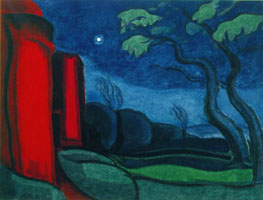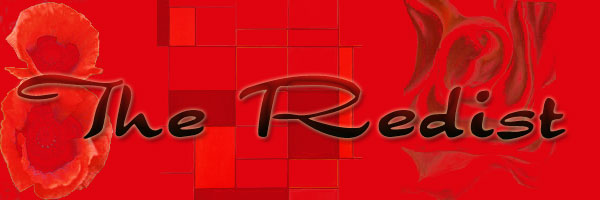Bluemner's Androgynous Mind

Oscar Bluemner, Venus, 1924, watercolor on paper.
Oscar Bluemner (1867-1938) was an important and influential, yet underrepresented figure in the Stieglitz circle and American modernism. An immigrant from
The exhibit at the Whitney Museum of American Art spans Bluemner’s career, charting his development of a personal painting language. His paintings of
Bluemner’s work began developing through logical formal changes as he implemented fracturing planes to reorganize space. He formed a devotion to Asian art and abstraction, stating “Art is Vision and Imagination . . . faithful representation is not art.” A dramatic turn occurred when Bluemner’s wife Lina died in 1926, plunging him into a deep state of grief and despair. Looking inward, he sought spiritual comfort, engaging in an existential dialogue with nature. The “Suns and Moons” series exhibited in February 1928 achieved new depths of emotional poignancy and sincerity. The works in this series use a similar schema : organized with a centralized celestial orb dominating the sky, trees or mountainous shapes, and occasional houses forming the lower valley or basin of the plane. The suns and moons, fundamentally archetypal and evocative forms, radiate with spiritual energies and ambient suggestions. Using color as a major expressive tool, Bluemner regarded these works as “symbols of the universal creative spirit,” exploring polarities of “body and soul, life and death, ecstasy and terror, and male and female.”
The elements Bluemner juxtaposed in his “Suns and Moons” are some of the most fundamental archetypes of the unconscious and correlate with Asian concepts of yin and yang, commonly associated with the “light” and “dark” in familiar symbolism. To this extent, Bluemner uses remarkably appropriate yet unexpected color relationships, such as captivating crimsons in Sun Storm (1927, watercolor on paper) surrounded by pale blues, rich greens, and navy, set off against grey-brown undulations of the land. In Sunset on the
As in Eye of Fate (1927, watercolor on paper), Bluemner demonstrates the consequence of cathexis, staring so intently at one point that all others become distorted and pushed to the sides of consciousness. The deep reds, which Bluemner associated with masculinity, passion, and aggression, fight against the deep turquoise sky. Crimsons, browns, and purples form rings of atmosphere which overwhelm the sky, drawing stronger contrast from the greys of the bowing warped rooftops and a curved blackish-brown telephone pole.
Bluemner used this series to transition into a new view of nature and landscape, applying psychological projection to panel paintings. He wrote, “analogy and imagination are freely used to transpose things into other shapes of life by way of association of ideas.” Later works explored “Ego,” “Nonego,” and “Unego” in a sophisticated modern way. His paintings became about human nature, more personal while investigating the universal. Using motifs of a house, a tree, and a sky or a canal, Bluemner created theatrical compositions describing all the complexities of modernity, while remaining sincere and personally significant.
Oscar Bluemner is a modernist painter deserving of more consideration and attention. By combining the unconscious elements of the psyche with the specificity of landscape elements and precisely-focused motifs, he developed an original and effective painting style, as well as a unique method for exploring the world around him. His paintings achieve a balance of androgyny, inhabiting important places in modern art and thought through fusion of archetypal polarities.
LINKS:
- John Haber on Bluemner, Haber's Art Reviews



0 Comments:
Post a Comment
<< Home